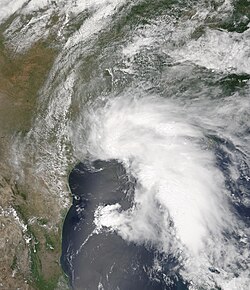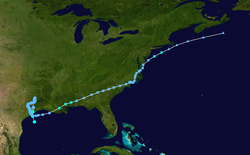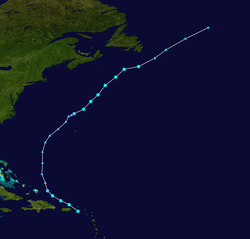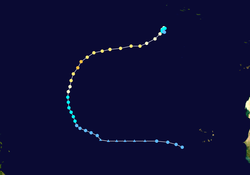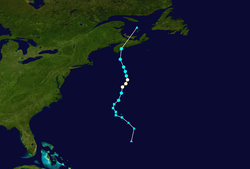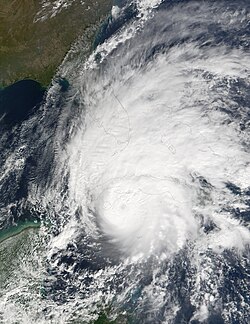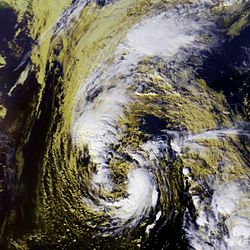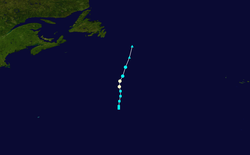The 2001 Atlantic hurricane season was a fairly active Atlantic hurricane season. The season had 17 tropical cyclones. Out of the 17 cyclones, 15 became named storms, 9 became hurricanes, and 4 became major hurricanes. A "major hurricane" is a storm that is above Category 3 on the Saffir-Simpson Hurricane Scale. The season officially started on June 1, 2001, and it ended on November 30, 2001. This time period is when tropical cyclones usually form in the Atlantic Ocean.
2001 Atlantic hurricane season

|
| First storm started:
|
June 4, 2001
|
| Last storm ended:
|
December 6, 2001
|
| Strongest storm:
|
Hurricane Michelle - 933 mbar (record), 140 mph winds
|
| Number of storms:
|
16 named storms + 2 depressions
|
| Major hurricanes (Cat. 3+)
|
4
|
| Cost of damage:
|
$7.1 billion (2001 USD)
$8.7 billion (2009 USD)
|
| People killed:
|
105
|
|
|
StormsTropical Storm Allison
| Tropical storm (SSHS)
|
|---|
|
|
| Duration
|
June 5 – June 17
|
|---|
| Intensity
|
60 mph (95 km/h) (1-min), 1000 mbar (hPa)
|
|---|
Tropical Storm Allison was the costliest tropical storm in United States history. Allison caused so much damage because she moved very slow over Texas. It took Allison about 4 days to move from Lufkin, Texas to the Gulf of Mexico. Allison left $5.5 billion in damage and killed 55 people. [1]
Tropical Depression Two
| Tropical depression (SSHS)
|
|---|
|
|
| Duration
|
July 11 – July 12
|
|---|
| Intensity
|
30 mph (45 km/h) (1-min), 1010 mbar (hPa)
|
|---|
Tropical Depression Two formed on July 11. Forecasters said that it might become a tropical storm. This did not happen. Tropical Depression Two died on July 12. [2]
Tropical Storm Barry
| Tropical storm (SSHS)
|
|---|
|
|
| Duration
|
August 2 – August 7
|
|---|
| Intensity
|
70 mph (110 km/h) (1-min), 990 mbar (hPa)
|
|---|
Barry formed as Tropical Depression Two on August 2. It later became Tropical Storm Barry. Barry moved west and weakened to a tropical depression and made a loop at the same time. Barry became a Tropical Storm again and made landfall in Santa Rosa Beach, Florida on August 6. Barry was last seen in Missouri. Barry killed 9 and left $30 million in damage. [3]
Tropical Storm Chantal
| Tropical storm (SSHS)
|
|---|
|
|
| Duration
|
August 14 – August 22
|
|---|
| Intensity
|
70 mph (110 km/h) (1-min), 997 mbar (hPa)
|
|---|
Chantal started from Tropical Depression Three on August 14. Tropical Depression Three weakened into a wave and was no longer a depression. It reformed but as a tropical storm it was given the name Chantal. Chantal crossed the rest of the Caribbean Sea and made landfall in Belize. Chantal died over Mexico on August 22. Chantal killed 2 people and caused $4 million in damage.
[4]
Tropical Storm Dean
| Tropical storm (SSHS)
|
|---|
|
|
| Duration
|
August 22 – August 28
|
|---|
| Intensity
|
70 mph (110 km/h) (1-min), 994 mbar (hPa)
|
|---|
Dean formed on August 22, it skipped becoming a tropical depression. Dean weakened and became a tropical wave and then reformed. It died on again on August 28 when a low that was not a tropical wave took over the storm. Dean left $7.7 million damage in Puerto Rico and Dean did not kill anyone.
[5]
Hurricane Erin
| Category 3 hurricane (SSHS)
|
|---|
|
|
| Duration
|
September 1 – September 15
|
|---|
| Intensity
|
120 mph (195 km/h) (1-min), 968 mbar (hPa)
|
|---|
Tropical Depression Six formed on September 1. It later became a Tropical Storm before weakening back to a tropical wave. It became a tropical storm again, and later a hurricane. Erin moved around it the Atlantic until dying near Newfoundland on September 15. Erin caused no damage and killed no one. [6]
Hurricane Felix
| Category 3 hurricane (SSHS)
|
|---|
|
|
| Duration
|
September 7 – September 19
|
|---|
| Intensity
|
115 mph (185 km/h) (1-min), 962 mbar (hPa)
|
|---|
A tropical wave off the coast of Africa organized into Tropical Depression Seven on September 7 while near the Cape Verde islands. It moved quickly to the west, and broke down to a tropical wave the next day. By September 10, the wave had reorganized, and it was again named Tropical Depression Seven. The depression continued to strengthen, and became Hurricane Felix by September 13. Now moving north, Felix intensified rapidly, reaching Category 3 status. Felix turned to the northeast and started to weaken. By September 17, Felix had dropped to tropical storm strength, and it died on the 19th. No damage was reported. [7]
Hurricane Gabrielle
| Category 1 hurricane (SSHS)
|
|---|
|
|
| Duration
|
September 11 – September 19
|
|---|
| Intensity
|
80 mph (130 km/h) (1-min), 975 mbar (hPa)
|
|---|
Gabrielle started as Tropical Depression Seven in the eastern Gulf of Mexico. As a depression it moved west and then moved back almost exactly the way it moved west. It because a tropical storm and made landfall in Venice, Florida on September 14. Gabrielle became a hurricane later on before it started dying while south of Newfoundland. Gabrielle killed 2 and caused $230 million in damage. [8]
Tropical Depression Nine
| Tropical depression (SSHS)
|
|---|
|
|
| Duration
|
September 19 – September 20
|
|---|
| Intensity
|
35 mph (55 km/h) (1-min), 1005 mbar (hPa)
|
|---|
Tropical Depression Nine was a short lived tropical depression. In formed on September 19 and made landfall in Nicaragua September 20. Nine died on September 20. Nine killed no one and caused no damage. Nine reformed in the Pacific and became Hurricane Juliette. [9]
Hurricane Humberto
| Category 2 hurricane (SSHS)
|
|---|
|
|
| Duration
|
September 21 – September 27
|
|---|
| Intensity
|
105 mph (165 km/h) (1-min), 970 mbar (hPa)
|
|---|
Tropical Depression Eight formed on September 21. It became a tropical storm and a hurricane later on. Humberto died on September 27, without affecting land. Humberto caused no damage and killed no one. [10]
Hurricane Iris
| Category 4 hurricane (SSHS)
|
|---|
|
|
| Duration
|
October 4 – October 9
|
|---|
| Intensity
|
145 mph (230 km/h) (1-min), 948 mbar (hPa)
|
|---|
Iris started as Tropical Depression Eleven on October 4. It became a tropical storm and a hurricane in the next few days. Iris tracked all the way across the Caribbean Sea. When Iris had its top winds it made landfall in Belize, which was on October 9. Iris weakened over land very fast. Iris died not even twenty hours after landfall. The remains reformed in the Pacific Ocean as Tropical Storm Manuel. Iris left $150 million and killed 49 people. [11]
Tropical Storm Jerry
| Tropical storm (SSHS)
|
|---|
|
|
| Duration
|
October 6 – October 8
|
|---|
| Intensity
|
50 mph (85 km/h) (1-min), 1004 mbar (hPa)
|
|---|
Tropical Depression Twelve formed on October 6. It later on became Tropical Storm Jerry. Jerry passed just south of Barbados on October 7. Jerry weakened and then died on October 8. Jerry did not kill any one and no one knows the damage caused by Jerry. [12]
Hurricane Karen
| Category 1 hurricane (SSHS)
|
|---|
|
|
| Duration
|
October 12 – October 15
|
|---|
| Intensity
|
80 mph (130 km/h) (1-min), 982 mbar (hPa)
|
|---|
Karen started as a subtropical storm. It became a tropical storm and a hurricane later on. The hurricane weakened to tropical storm before making landfall in Nova Scotia on October 15. Karen died on the same day of landfall. There was no one killed by Karen, but there was $1.4 million in damage from Karen. [13]
Tropical Storm Lorenzo
| Tropical storm (SSHS)
|
|---|
|
|
| Duration
|
October 27 – October 31
|
|---|
| Intensity
|
40 mph (65 km/h) (1-min), 1007 mbar (hPa)
|
|---|
Tropical Depression Fourteen formed on October 27. It became Tropical Storm Lorenzo on October 30. Lorenzo died on October 31 without coming anywhere near land. [14]
Hurricane Michelle
| Category 4 hurricane (SSHS)
|
|---|
|
|
| Duration
|
October 29 – November 5
|
|---|
| Intensity
|
140 mph (220 km/h) (1-min), 933 mbar (hPa)
|
|---|
Tropical Depression Fifteen formed on October 29. Fifteen stay over Nicaragua for about 36 hours, before going into the Caribbean Sea and becoming Tropical Storm Michelle. On November 2 Michelle became a hurricane. The hurricane strengthened very fast and was a category 4 by the next day. Michelle struck Cuba and the Bahamas twice before it started dying on November 5. The dying storm completely died a little bit south of Bermuda. Michelle killed 17 and left $2 billion in damage. [15]
Hurricane Noel
| Category 1 hurricane (SSHS)
|
|---|
|
|
| Duration
|
November 4 – November 6
|
|---|
| Intensity
|
75 mph (120 km/h) (1-min), 986 mbar (hPa)
|
|---|
Hurricane Noel was a short-lived hurricane that started as a subtropical storm. On November 5 it became Hurricane Noel. Noel died the next day without affecting land badly. The remains caused high winds and waves in eastern Canada. No one was killed and there was no damage. [16]
Hurricane Olga
| Category 1 hurricane (SSHS)
|
|---|
|
|
| Duration
|
November 24 – December 6
|
|---|
| Intensity
|
90 mph (150 km/h) (1-min), 973 mbar (hPa)
|
|---|
Olga started on November 24 as a subtropical storm. It quickly became a tropical storm. On November 26 it became Hurricane Olga. Olga later on weakened and finally died on December 6. Olga had no affect on land. [17]
Storm names
These names were used for tropical storms and hurricanes that formed in the north Atlantic in 2001. This is the same list that was used for the 1995 season except for Lorenzo, Michelle, Olga, and Rebekah. Lorenzo, Michelle, and Olga were used for the first time in 2001.[18] Names that were set aside for the 2001 season, but were not used, are marked in gray.
- Allison
- Barry
- Chantal
- Dean
- Erin
- Felix
- Gabrielle
|
- Humberto
- Iris
- Jerry
- Karen
- Lorenzo
- Michelle
- Noel
|
- Olga
- Pablo (unused)
- Rebekah (unused)
- Sebastien (unused)
- Tanya (unused)
- Van (unused)
- Wendy (unused)
|
Retirement2001 Atlantic Hurricane Season MediaReferencesOther websites

